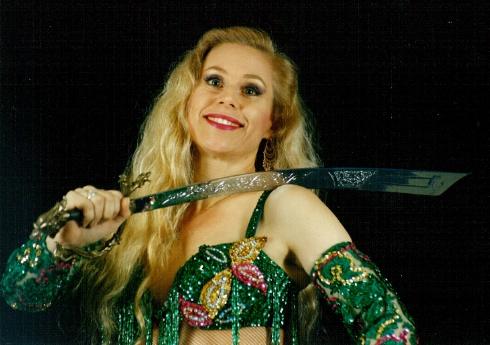|
Double Sword Dance

Marriot Hotel, Amman Jordon
The legends of a
certain Moroccan coastal tribe say that once, when the men were away at
war, the home village was taken by enemies. That night the women of the
village danced to entertain these new conquerors. Their performance was
so mesmerizing that the warriors allowed them to use their swords in the
dance. As the captivating dancers stole the hearts of their audience,
they also took their weapons. When enough of the swords had been
gathered, the seductresses turned them on their disappointed admirers
and held them prisoner until their own soldiers returned.
That is one of the stories of the origin of sword dancing as it is done
in middle eastern dance. The women who captured the enemy soldiers were
considered heroes, and were honored (by a tribe that made much use of
symbolic tattoos) with a specific tattoo worn on the forehead, down
close to the eyes. The tradition of sword dancing among Moroccan tribes
has been handed down through the generations.
Handle with Respect
If you were thinking of borrowing from this tradition and dancing with a
sword, always handle it with respect. Remember that it is a weapon—its
purpose is to cut. Never touch the edge of the blade (even though in
your stage version it may be blunted) for that will destroy the illusion
of all that the sword symbolizes: Power, grace, masculine energy. It is
the tool that draws the line between life and death.
Before you buy a sword, make sure it balances well. Dancing with the
sword balanced on your head is the heart and soul of the Moroccan Sword
Dance. Before you try dancing with it, get used to walking with the
sword on your head. It is okay if it rocks a little; it is not supposed
to be perfectly still. Learn how much movement you can sustain without
dropping the sword. As you start to really dance with it, you will learn
how to use that movement to your advantage.
Slow Music
Sword dancing is usually done with very slow music; perhaps
chiftetelli or tasqim. With the sword still on your head,
start doing a couple of your chiftetelli steps; use hip circles
and chest circles—a series of hip circles followed by a series of chest
circles, then alternate between them. Add other slow movements as you
get comfortable—belly rolls, and Egyptian arms. Try not to hit the sword
with your arms while it is balanced on your head. If your arms do touch
the sword, don't panic: let it rock and come back to center. If
necessary, use both hands to adjust the sword.
You can introduce the sword into your dance at the beginning of the
piece by dancing with it in your hands. (If you have ever heard The
Sword Dance on Dream Dancer by Light Rain—the piece Maria Masselos
uses for her candelabra dance—Doug used to play that drone at the intro
for as long as I danced with the sword in my hands. He would start the
chiftetelli rhythm the instant I placed the sword on my head.
Sword Movements
There are many things you can do while holding the sword: hold it with
both hands high over your head (do not touch the cutting edge); spin
with it held that way; caress the underside of the blade. Some dancers
like to balance it on their hip or their arm, or you may even want to do
some martial slicing motions; but I prefer the beauty of balancing the
power rather than demonstrating aggression.
Advanced Techniques
After you have balanced the sword on your head and you have gone through
some of your basic slow movements, there are some more advanced
techniques of sword dancing you may want to try: floor work and spins.
With the sword balanced on your head, it is possible to do backbends and
a whole repertoire of movements on the floor, as long as your head stays
upright. From a standing position, spins can be performed slowly with
the sword following the body around. You can gradually build up momentum
and then stop, allowing the sword to keep spinning half way around
several times. This takes much practice, and you should never try to
perform it until you have done it hundreds of times privately. At best,
if the sword falls, you will probably grab it by the blade, ruining the
illusion of its ability to cut (or there would be fingers on the floor);
at worst it could hit somebody and really hurt them.
Blood on the Floor
Sword dancing doesn not work perfectly every time, no matter how much
you have trained with it. Once I was performing with Light Rain in a
very crowded nightclub. I was on a slightly raised stage with the
musicians seated next to me on the hour. I spun and stopped; the
audience gasped as the sword kept spinning and then fell point down in
the tiny space between the violinist and the drummer—and my sword is
heavy with a sharp point! Miraculously, nobody was hurt, and no
instruments were damaged. The incident taught me a humility and respect
her the sword, even as an object for dance, that we should all cultivate
every time we pick one up.
Sword dancing is not for everyone. If you choose to practice this,
remember that when you dance with a sword you are an image of Shiva; and
remember the seductive heroines who disarmed the men who would have
dominated them.
(Written by De Ann, Volume 1, Number 2, November
1995—The Sistrum)
HOME | BIOGRAPHY
| PHOTOS | ARTICLES &
REVIEWS
INSTRUCTION |
EVENT CALENDAR | STORE |
CONNECT

|